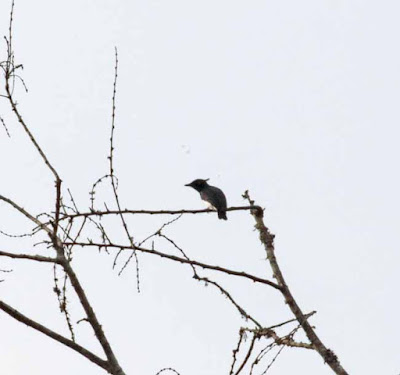In this bulletin we will see 3 small families of birds. All were life birds in this bulletin.
The first is the wattle-eye and batis family. There are 31 species in the family and I photographed 4 on the trip. The batises are small plump big headed black and white birds.
The 4" male Western Black-headed Batis (Batis erlangeri) is easily IDed as a batis by the coloration. But best ID is voice. The female would have a brown breast band.
 |
| Western Black-headed Batis - male |
Next is the 3.5" Rwenzori Batis (Batis diops). It is found in the Rwenzori Mountains above 5000' in the Albertine Rift. If you look closely there are 2 white dots on the face - an important ID mark.
 |
| Rwenzori Batis |
I also saw my first wattle-eyes in the same area. The 5" female Brown-throated Wattle-eye (Platysteira cyanea) has a red wattle.
 |
| Brown-throated Wattle-eye - female |
Interestingly, these birds are named for the female coloration. The male has a smaller black throat band.
 |
| Brown-throated Wattle-eye - male |
The 4" female Chestnut Wattle-eye (Platysteira castanea) is a chestnut bird with a gray head and white belly. The wattle is purplish. I did not see a male, but he is black and white like a batis.
 |
| Chestnut Wattle-eye - female |
The next family are African warblers and crombecs. There are only 18 species and I photographed 4 and missed a photo of a 5th.
The tiny crombecs appear almost tailless. The 3.5" White-browed Crombec (Sylvietta leucophrys) is grayish with olive wings and a wide white eye stripe.
 |
| White-browed Crombec |
The 3.5" Green Crombec (Sylvietta virens) is completely dull olive gray.
 |
| Green Crombec |
The 3" Northern Crombec (Sylvietta brachyura) is gray above and buffy below.
 |
| Northern Crombec |
At 7" in length, the Moustached Grass Warbler (Melocichla mentalis) is the giant of the family. It has a brown back, buffy underside and 2 white facial stripes.
 |
| Moustached Grass Warbler |
The vangas were an endemic family to Madagascar, but I guess DNA showed a close relationship to the helmetshrikes and they were merged a few years ago. There are 39 species in the combined family.
The 6" male African Shrike-flycatcher (Megabyas flammulatus) is a clean black and white bird with a red eye. The female was not seen but she is brown with a streaked chest.
 |
| African Shrike-flycatcher |
Lastly is the 5" male Black-and-white Shrike-flycatcher (Bias musicus). This black and white bird was at the top of a very tall tree and would not respond to the tape and come closer. He has a crest as the ID mark.
 |
| Black-and-white Shrike-flycatcher - male |
One thing that has interested me for a long time are national birds. Now that I have done photography on several continents, I decided to look up national or official territorial birds. Some places do not have designated birds, so if they have the bird on their coat-of-arms, I used that bird. Despite the fact I have I have photographed in just a dozen countries, I have photos of the birds of 83 countries or territories.
I did the same for the USA states and territories as well as the Canadian provinces. You can see them here.
I put the different bird/mammal families in single folders for easy viewing
I have photos of 7 of the 31 species of batises and wattle-eyes
I have photos of 6 of the 18 species of crombecs and African warblers
I have photos of 3 of the 39 species of vangas and helmetshrikes
Happy birding and photography,
David McDonald
dkmmdpa@gmail.com
photos copyright 2006 - 2020 David McDonald
To have these trip reports sent to your email, please email me at the above address and ask to subscribe.
I put the different bird/mammal families in single folders for easy viewing
I have photos of 7 of the 31 species of batises and wattle-eyes
I have photos of 6 of the 18 species of crombecs and African warblers
I have photos of 3 of the 39 species of vangas and helmetshrikes
Happy birding and photography,
dkmmdpa@gmail.com
photos copyright 2006 - 2020 David McDonald
To have these trip reports sent to your email, please email me at the above address and ask to subscribe.
No comments:
Post a Comment